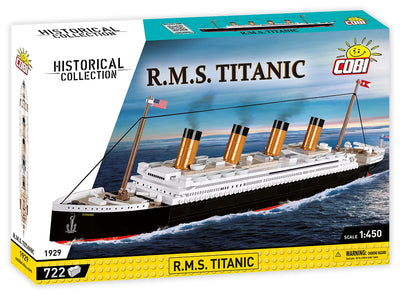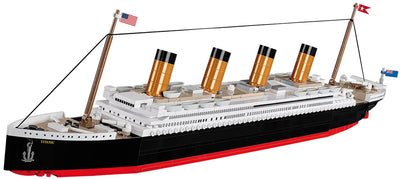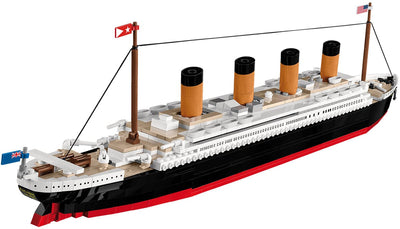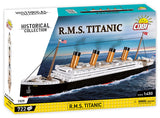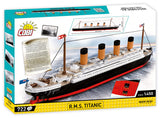Model Spec.
- 722 bricks
- 1:450 scale
- Bodywork with pad printing
- Easy-to-follow instruction manual
- Block with name of ship
- Compatible with other leading brands of construction blocks
- Length 64cm, Height 15cm.
This stunning self-build, brick model of the ill-fated but legendary RMS Titanic will make a fascinating talking point when placed on display in your home. Providing hours and hours of enjoyable building time and a great opportunity to immerse yourself and your family in the history behind the ship. The set has 4 funnels, numerous decks, lifeboats, masts, and rotating turbines.
History.
The RMS Titanic, an iconic British passenger liner, tragically sank on its maiden voyage, leaving an indelible mark on maritime history. Constructed by the Harland and Wolff shipyard in Belfast, the Titanic was one of three Olympic-class ocean liners commissioned by the White Star Line. Designed by J. Bruce Ismay and built under the direction of Thomas Andrews, the ship was intended to epitomise luxury and safety.
Laid down in 1909, the Titanic was the largest ship afloat at the time of its launch in May 1911. Measuring 882 feet in length and weighing over 46,000 tons, it boasted state-of-the-art technology and opulent interiors, including a grand staircase, luxurious dining rooms, and even a swimming pool. The ship was equipped with 16 watertight compartments, leading to the belief that it was "unsinkable."
The Titanic set sail from Southampton, England, on April 10, 1912, destined for New York City. It carried 2,224 passengers and crew, ranging from wealthy industrialists in first class to immigrants in third class. The voyage symbolised the height of Edwardian luxury and modern engineering.
On the night of April 14, 1912, the Titanic struck an iceberg in the North Atlantic. Despite the ship's advanced design, the iceberg caused fatal damage, flooding five of the watertight compartments. In the early hours of April 15, the Titanic broke apart and sank, resulting in the deaths of over 1,500 people. The insufficient number of lifeboats, designed to accommodate just over half of those on board, contributed to the high casualty rate.
The sinking of the Titanic shocked the world and led to significant changes in maritime regulations, including improved lifeboat requirements and the establishment of the International Ice Patrol. The shipwreck was discovered in 1985, sparking renewed interest and numerous explorations.
The Titanic's story continues to captivate the public imagination, symbolising human hubris and the fragility of technological advancements. Its legacy endures in countless books, films, and exhibits, serving as a poignant reminder of the tragic consequences of overconfidence and inadequate safety measures.
Reviews.
Shipping.
- BrickTanks offers multiple shipping options. Visit the following Shipping page for more details.
 Skip to content
Skip to content


